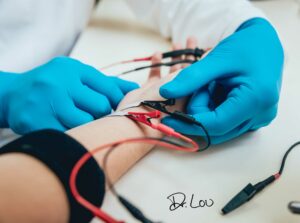Dr. Lou’s EMG experience.
Dr. Lou’s New & Improved Empathy.
Recently, in an effort to rule out serious neurological disease, I finally had an appointment today with a neurologist, who performed an exam and EMG on me. For many, the thought of this test makes them stressed, scared, concerned and fearful of the outcome and pain of the test. I was extremely concerned about the results. I now have a new appreciation, understanding and empathy for those who need this, and other tests for serious disease.
What does the test consist of?
During the test, one or more small needles (also called electrodes) are inserted through the skin into the muscle. The electrical activity picked up by the electrodes is then displayed on a monitor. EMG measures the electrical activity of muscle during rest, slight contraction and forceful contraction. Muscle tissue does not normally produce electrical signals during rest. When an electrode is inserted, a brief period of activity can be seen on the oscilloscope, but after that, no signal should be present. (Source: www.hopkinsmedicine.org) Depending on the results of conductivity, the doctor may be able to diagnose and/or rule out, certain conditions of the nervous system. When indicated, I have often sent patients out for this very test.

Dr. Lou shares his EMG experience. #empathy
Was The Test Painful?
Dr. Jacques Reynolds at Mid Coast Neurology was great. The test was uncomfortable at times but was tolerable, and was far from painful in a way that should make you worry about the test. My concerns regarding discomfort were unnecessary.
How did it feel?
The EMG testing felt like a cross between acupuncture and electrical stimulation from a “TENS Unit.” The current of electricity did cause some twitching of muscle that I certainly felt, but it was tolerable. If you’ve had acupuncture with electrical stimulation at my office, it feels like that, just a bit more intense.
How long did the EMG testing take?
Testing took no more than 15 minutes in my case, and was probably closer to 8-10 minutes. Dr. Reynolds only felt the need to test the lower half of my body.
How does it feel after the test?
A couple of spots on my legs feel sore, but no different than an achy bruised feeling. I left the test and immediately drove home and came to work. I feel fine.
Why getting help is so helpful…
For the past 3 months, I’ve been waiting for this appointment wondering if my time was limited. I had serious and legitimate concerns and the moderate to worst-case scenarios were really bad. I now understand what it’s like to fear that you will need to tell your child about a terminal illness. I’ve experienced in the past few months what it’s like to show up to work, do your best for everyone around you, but all while you feel like you are going to be told you that your time is up. With my family and friends supporting me emotionally, some knowing my circumstances, others not, they helped me tremendously get to this day of testing. My test results were great. I don’t have the terminal illness I thought I had. Getting help is so helpful because your worries may be put to rest when you get your results. God forbid, you get terrible news, at least you can begin to take action to make life as good as possible. In either case, a shift of thinking and action can change your life, for the remainder of it, for the better.
How have my experiences changed what you could experience in our office?
Empathy and clarity have always been cornerstones of my work. Feeling listened to as a patient and person in our office has always been a priority. What I have experienced recently brought me even closer to the human condition. I have also experienced the “high deductible, pay out of pocket for everything” pain as well. I go to the gym 4-5 days a week, I eat very well, I get adjusted regularly, maintain a healthy immune system and I take my supplements. I do everything I should be doing proactively, and for those of you who do the same, our office is going to reward you.
$20
For patients who meet the criteria for maintenance, wellness or preventive care there is a new flat cash fee for an adjustment of $20. Less than most copays, this price is designed to eliminate all financial barriers to care. For proactive, healthy, less subluxated people, this reduced fee will in no way compromise our standards of care, your adjustment will be just as great as it should be. For more information, or to learn if how one “qualifies” for this fee, email or call anytime.
Respectfully,
Dr. Lou
